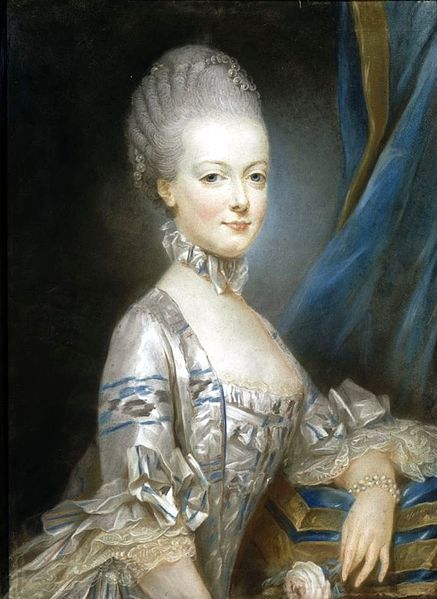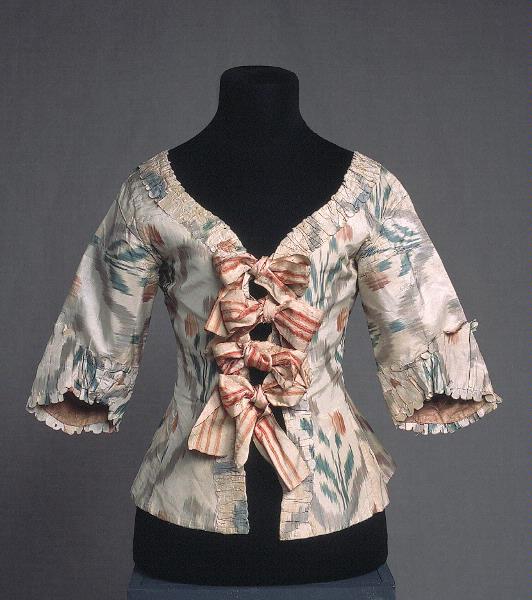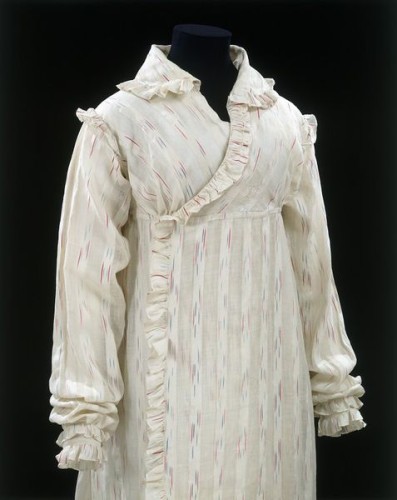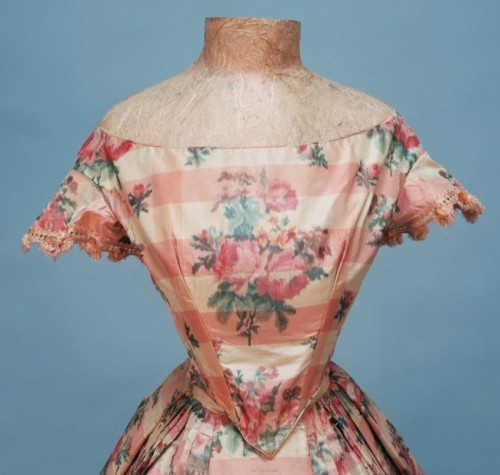Ikat (also spelled ikkat), abr (also spelled ebru), warp-printed and chine (or chine a la branche) are different names for variants of the same technique: fabric woven from yarns which have been pre-dyed (using a resist method) or printed with the intended pattern, producing a characteristic soft, blurred pattern once the yarns are woven into a cloth.

Robe à la Polonaise of chine silk (detail) ca. 1780, British, silk, Metropolitan Museum of Art 1981.245.2
Strictly speaking, ikat and abr are created by pre-dying the threads with a resist dye method before weaving, and chine and warp-printing are created by printing the warp threads before weaving, though the line between the two different techniques, both in which fabrics are called which, and in how the fabrics are produced, is as blurred as those on the fabrics they describe.
Ikat is the Indonesian term (from the Malay mengikat ‘to bind’), and is the most commonly heard name for the fabric in modern times. 18th century fashion enthusiasts will know the French name, chine or chine a la branche, which specifically refers to multi-coloured warp-patterned fabric, and Pompadour silk, a later English term for the same fabric. More prosaically, English-language sources also call it by the technical description of ‘warp-printing’. Finally, there is the Turkish terms abr, which literally means ‘cloud’, an apt description for the soft edges of the resulting designs.
The ikat dyeing and weaving technique goes back millenia, and was developed independently in different parts of the world: there are very old examples from Japan, Indonesia, Turkey, Yemen, and pre-Columbian South America.

Fragment from an Ikat Shawl, late 9th—early 10th century, Yemen, Cotton, ink, gold; plain weave, resist-dyed (ikat), painted, Metropolitan Museum of Art, 29.179.10
Ikat, under the name chine, became popular in Europe in the mid-18th century as part of the craze for Eastern designs and fabrics. The name chine literally means ‘Chinese’ in French, because of the fabric’s association with China and the East. Though the first examples probably did come from China, by the 1760s France was producing its own warp printed chine fabrics.

Robe à la Francaise (detail), French, 1760s, chine silk, LACMA
According to the Kyoto Costume Institute, the fabric was frequently worn by and particularly associated with Madame de Pompadour, and so is sometimes called ‘Pompadour taffeta.’ However there is a bit of doubt and confusion around this term. First did Madame de Pompadour even wear chine a la branche? If Madame de Pompadour did ever wear a dress of chine silk, she would have been on the forefront of the fashion (which is, of course, entirely fitting with her character) as the first examples of chine silk gowns date from the mid-1750s. Pompadour died of tuberculosis in 1763.

Dress of chine silk, 1755—65, French, silk, Metropolitan Museum of Art, 50.168.1ab
The first usage of the term, in English, not French, of course, dates to 1762, when Mr. Clarke “dressed in pompadour, with gold buttons; and his lovely Dolly in a smart checked lutestring, a present from her mistress” are mentioned in Smollet’s ‘The Life and Adventures of Sir Launcelot Greaves.’ However the fabric described by Smollet may not have been a chine taffeta at all, but a different fabric altogether. Further references to fabrics as Pompadours confuse the matter even further. Almost ever decade of the 19th century called a fabric ‘Pompadour’, usually meaning something that combined flowers and stripes, though the ground ranged from wool to dupion to specifically black. When reading a reference to Pompadour silk/taffeta/chine it’s difficult to tell exactly what fabric is meant by the reference.

Robe à la Française, 1760—70, French, silk, Metropolitan Museum of Art C.I.60.40.2
In 1768-9 the barely-teenage Marie Antoinette was painted in a gown of chine silk in a portrait that was sent to her prospective bridegroom so that he could see his intended bride. The gown in the portrait is more fashionable than grand, and Marie Antoinette wears no jewels except for the ubiquitous pearls. It’s an interesting portrait: the gown gives an impression of culture, worldliness, knowledge. Or perhaps her gown was just meant to give a subtle nod to France’s textile industry, as the chine for Marie Antoinette’s dress was likely have to been woven there.

Marie Antoinette in a dress of chine a la branche, at the age of thirteen; by Joseph Ducreux (1769)
Chine silks reached the heights of their popularity in the 1770s & 80s, and though they were still considered exotic, and certainly luxurious, they were far more likely to have been made in France than in China. France was even weaving chine combined with velvet: an incredibly difficult, and thus expensive, process.

Jacket, late 18th century, Kulturen
Chine gradually fell out of fashion in the 1790s, though there are a few examples of chine, both in silk and, more unusually, in cotton, in Regency dress, and 18th century chine fabrics were likely re-used throughout the 19th century.

Evening overdress, 1797—99, British, silk, linen, Metropolitan Museum of Art, 2009.300.219

Peignoir, India (fabric) Great Britain (garment), 1812-1814, muslin dyed in the ikat technique, T.798-1913 V&A Museum
Chine saw a major re-surgence in popularity in the 1840s-1860s. In contrast to the larger, softer, more abstract chines of the 18th century, or the very simple geometric chine of the first decades of the 19th, mid-19th century chine silk tended to be more literal; with smaller, brighter, easily recognisable floral patterns.

Gown of warp printed silk satin, late 1840s, Augusta Auctions

Ball gown, warp printed silk, 1840s, Whitaker Auctions
In 1859 Theodore de Banville described an old woman “dressed in the most irritating height of fashion. Over a dress of pompadour taffeta in white with designs of flowers, fruit and birds she wore a tulle mantelete, striped in velvet with two great flounces in chantilly lace.”

Dress of chine silk worn by Sofia of Nassau, Queen of Sweden, circa 1850, Royal Armoury Collection, Sweden
Though it never returned to the popularity it had enjoyed in the late-18th and mid-19th century, chine fabric and ribbons continued to be used in fashion throughout the 19th century, and were produced in France into the early 20th century. The flower strewn Jean-Phillipe Worth dress that you found so charming as a Rate-the-Dress was made from chine silk.

Evening dress (detail of bodice), House of Worth, Jean-Philippe Worth, 1902, French, silk, rhinestones, metal, Metropolitan Museum of Art
Ikat, as a term, wasn’t used in English until the 20th century, but has since become, along with warp-printing, the most widely used and recognised term for the technique. While chine lost its original exotic connotations, ikat continues to be used in fashion and furnishing to evoke a distinctly ethnic and organic feel.

Cocktail ensemble of ikat, Bonnie Cashin (American, 1915—2000), Eunice Cashin (American) 1957, silk, wool, Metropolitan Museum of Art, 2009.300.3285
There is also a very rare variant of ikat, double-ikat, where both the warp and weft threads of the fabric are pre-dyed.
Sources:
Cumming, Valerie and Cunnington, C.W.; Cunnington, P.E, The Dictionary of Fashion History (Rev., updated ed.). Oxford: Berg. 2010
Fukai, Akiko. Fashion : the collection of the Kyoto Costume Institute : a history from the 18th to the 20th century. Köln [etc.]: Taschen. 2002. p. 56.
Scott, Phillipa. The Book of Silk. London: Thames & Hudson Ltd. 1993
“Printing of Silk Warps for the Manufacture of Chine Silk”. Posselt’s Textile Journal. December 1907. Retrieved 12 December 2012.

That explains why I know of the technique only as “ikat”. Thanks as always for a very informative post.
Why do you know it only as ‘ikat’? I’m glad you enjoyed it!
Beats me; I’ve never read or heard any of the other terms before I read your post. Just a gap in my education, I guess. 🙂
Ah! I thought it might have been something about your area of expertise, and ikat being an older technique than warp printing!
Nope. In fact, I don’t know a whole lot about ikat (except that there’s no evidence that the Vikings used it). 🙂
In India, it’s “patola”. I’ve come across a very few organza saris with pastel patterns similar to chine a la branche.
Good point! I almost covered patola as well, but it got too long and complicated. Patola is not just ikat/chine, but double ikat, with both the warp and weft threads pre-dyed, creating an extremely detailed, precise pattern. The term ‘patola’ can also refer to the lengths of fabric themselves, not just the pattern, and to other pattern variants, depending on the timeperiod, so it was something I intended to do a full post of its own on.
I would like to read that post. I really enjoyed this one, but I do think patola deserves its own post.
This is super interesting. I love learning about specific fabrics. Do you know of any place you can buy this stuff these days? It’s easy to find ikat I guess, but probably harder to locate chine.
Thanks Claire! Different styles of ikat/chine come in and out of fashion. Because both have been quite popular in furniture and fashion in the last few years you have been able to get both – my local high-end fabric store (The Fabric Store) has had about 6 different silks or silk/cotton, silk/linen blends with patterns that are very reminiscent of 18th century chine a la branche. I’ve also seen some cottons that look like the 1810s cotton I posted. I haven’t seen any good facsimiles of mid-19th century warp-printed silks lately (nor anything nearly as sublime as the fabric of that 1900s Worth gown), but eventually fashion will bring them in. I suggest searching under warp-printed silks, but it is something that you just have to wait for fashion to bring in, because it isn’t a look that is produced all the time.
youtube.comInteresting but I am surprised by your definition of ebru. It is a printing technique, where a design is painted onto the surface of water in a tank and then a print taken off the surface of the water, usually on paper, but it can be on some fabrics too. Here’s a friend of mine demonstrating: http://www.youtube.com/watch?v=v_aMqMfdmLw&feature=youtube_gdata_player
Interesting. I will admit that only one of my sources (Scott’s Art of Silk) offered ebru as an alternative spelling of abr, so perhaps her information was incorrect, and I apologise for passing it on. However, on thinking on it, I wonder if, historically, there was a link due to the visual similarities between the soft patterns of marbled paper and the the soft patterns of ikat? ‘Marbled fabric’ would make sense as a descriptive name for ikat, and using ebru/marbleing dyeing to colour fabric is both uncommon and fairly recent. Prior to that, calling ikat ‘marbled fabric’ doesn’t seem beyond the stretch of language, just as in English we call moire silk ‘watered’ silk, not because it is actually watered, but because it looks like the surface pattern of water…
Abr is definitely the name for ikat in Turkey/Uzbekistan/much of the rest of Central Asia, and ikats from these area are frequently sold as abr. The question is, is are the words abr and ebru related, and was ebru really a different spelling? Sounds like I need to do more research!
I speak Turkish, and “abr” is not a possible word form in Turkish, so I guess it’s a foreign (French?) form of “ebru”, which is a classic Ottoman art form (still very much alive here). I think you are probably right that the use of the term for woven, rather than printed fabrics, is to do with the similarities in appearance, rather than technique. That zig-zag pattern common in ikat fabrics is relatively easy to draw and common in ebru prints.
Hmmm…fascinating! It definitely seems to be the word for ikat in Uzbek, which is a Turkik language, though as you say it may be a foreign form. I really do want to do more research into how the terms/techniques are related now!
Japanese meisen silk often involves pre-dying the threads as in the ikat process. Often used as a catch-all term, Meisen refers to the silk fabric, with dying practice separate: ie: not all meisen fabric is ikat-dyed. There’s a great description of the process at the page below, including photographs of the actual dying/printing the silk on the loom. Fascinating.
http://johnmarshall.to/blog/2012/05/10/textile-of-the-weekmeisen-gasuri-%E9%8A%98%E4%BB%99%E7%B5%A3-201219/
Fascinating, thanks for sharing! I know Japan is one of the places that still regularly produces ikat, and own a few pieces of beautiful Japanese ikat (including a stunning ikat silk kimono jacket) but I’ve never seen how it is done.
Oh! I have such a love affair with chine.
I was lucky enough to find a somewhat decent impression of 18th century chine fabric by searching Uzbek ikat. Most of what’s for sale is very tribal looking, with bold colors, but I was able to find a pastel, floral silk. Score! The motif is a little large, but it was the closest I could find, so far. I can’t wait to make something from it.
Caroline
Wonderful! In looking at lots of 18th century chine a la branche closely, I was really surprised about how many of them are large scale geometric prints, not small florals at all.
Ikat is back in current fashion in a big way. I’ve seen it being copied in ready-to-wear and a lot of home-dec stuff quite recently… it’s even listed as a Spring 2013 fashion trend! Places like anthropologie, h&m, ralph lauren, and topshop have recently featured printed ikat and jersey with printed ikat. I guess doing it the original way is too costly. I think it’s really interesting that I had heard of it through a call for submissions in the knitting world before seeing your detailed history. 😀
http://images.anthropologie.eu/is/image/Anthropologie/28030633_049_b?$uk_pdt_medium$
Are some kimono fabrics like kasuri also considered ikat?
Teaching textile design, we actually think ikat is rather passe 😉 In NZ it was cutting edge maybe in 2010 – by 2011 it was on-trend, 2012 it was waning, and now it’s definitely over! The joy of that, as a historical costumer, is that I can wait for the trend to be over and then buy the historically appropriate fabrics at discount without being worried about trends.
The printed ‘ikat’ actually really bugs me. It’s just so…wrong! Ikat is a weave, a print of it is just not right.
Some kasuri are ikat, not all.
Hah! I think this modern age is filled with a mish-mash of trends from every bygone era. I agree with printed “ikat” being weird. I don’t like that it looks like it should be woven, but then when printed on jersey, and it stretches, you see the base fabric underneath. That makes me cringe.
((pursed lips reaction))
Hehe. You purse your lips. I wince. 😉
I actually love the way textiles and fashion recycle trends – we’ve been doing it basically since textiles were invented, and we’ll keep doing it for as long as I can imagine! It’s fun that paisley comes in to fashion, but it can be ‘2013 does 1960s paisley, which was doing 1830s paisley…etc, etc!’
Did you see the chine velvet and striped satin gown in the V&A? (formerly from Castle Howard collection)
http://collections.vam.ac.uk/item/O85966/robe-and-petticoat-unknown/
LOVE chine silk – even once wrote a historical “friller” called “Pompadour Taffeta” (EMBARRASSINGLY ANACHRONISTIC) in my youth….
Not only did I see it, but if you read closely, I’ve linked to it when I talk of combining chine and velvet! My one grump about that gown is that none of the images are close enough for you to really see the velvet combined with chine. What’s the point of telling us all about if we can’t really see the fabric!
Oh dear re: Pompadour Taffeta. Not sure I want to know!
Must read better! There’s a close-up photo of the fabric in the Castle Howard book.
The book was actually more like a “sparky young heroine comes to creepy house in the back of beyond which is reputed to be haunted…” story – low on romance, high on hijinks. Load of nonsense, but rather amusing in retrospect.
Regardez. http://katmax1.livejournal.com/5437.html
Not the best photo (they were taken in the 1970s, I suspect) but that’s the same dress.
Thank you and oh my! Back in the days of using live models as mannequins! I recognise the other garments as well.
Thanks to this post, I was able to look incredibly cultured while out shopping today. A posh furnishings store had winged armchairs upholstered in an ikat print. I love getting to use new words!
facebook.comFascinating! I had never heard of chine before but recently bought some lovely grey floral silk from global fabrics that’s not unlike your examples, I wonder how it’s produced commercially?
If you ever find yourself in Bangkok this museum forms part of the palace:
https://www.facebook.com/pages/Queen-Sirikit-Museum-of-Textiles/291155517564228
and has lots of examples of garments made with thai ikat.
Oooh…I have drooled over some of the chines that Global-that-was has, but the one I liked best sold before I could convince myself to buy it. And thank you for adding another museum to my list that I must visit!
What a lovely technique and such and informative post I must look again at some vintage ribbons I have.Thank you!